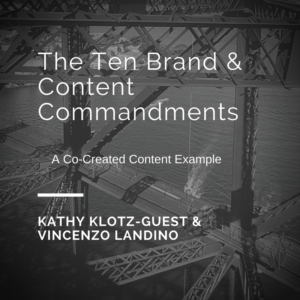A Little Background
Vincenzo Landino and I chatted a few weeks back for his Brand Boost podcast. We talked about improv and marketing, Happy Days, how “human” – yes, still an important word – has also ironically jumped the marketing shark.
We also talked about why all marketers should think like improvisers whose central tenet is “yes and.”
That is how improvisers build scenes together. This means you accept a statement made to you and add onto that idea so you are co-creating in a purposeful way. Of course, we also talked about all of this in the context of my new book: “Stop Boring Me! How to Create Kick-Ass Marketing Content, Products and Ideas Through the Power of Improv.” And, yes, I think every businessperson should take an improv class.
The Power of a Co-Created Example
And when we were done chatting, we talked excitedly (I get excited when people “get it!”) about how improv is fundamentally about being collaborative. That is how content creation can be and be better for it. This flies in the face of a very specific barrier to being more open and more collaborative with other parts of the organization and with customers for creating great content – control. In short, companies that think they control the brand are not only misguided (there is no such thing); they are getting in their own way when it comes to creating better content with others.
Vincenzo and I ‘yes-and-ed’ each other on an idea that needed to be written. And that conversation inspired the list below. And, in true “improv” fashion, I wanted this article to be a collaborative effort as well. So I wrote this up, told Vincenzo about it and sent it to him for his additions. This piece below represents that co-created content idea (to illustrate how this can work, we went back and forth several times on this piece and voila!).
The Ten Brand Commandments: ‘Yes, and-ed’ Content – Kathy and Vincenzo
1. The customer always has the final word on the brand. It doesn’t matter what you say about your brand or products, if your customers aren’t happy or advocating for you, you have nothing.
2. Great content comes from saying “yes and” to customers. Great content starts and never ends. It just evolves. For example, a great piece of content that is created around customers’ passions can be the beginning of powerful serial storytelling. “Yes, and-ing” is an ongoing process. It’s a mentality and the way marketing should operate.
3. Great content comes from saying “yes and” to great employee and partner ideas – to ideas that come outside of marketing and the organization. Employees closest to the customer and working on day-to-day brand details have the best story ideas. They are the ones interfacing with the customers consistently. Empowering those employees to tell their stories is saying ‘yes’ (and!) to more sales. It’s a no brainer.
Embrace and Empower Employee Storytellers
4. All employees are storytellers, and they are the best brand champions. You don’t think that only the CEO of a big company has a great ‘rags-to-riches’ type story, do you? I am yes, and-ing that, Vincenzo. That means not empowering your best employee advocates is a big mistake. These people are the human face and lifeblood of your company. And customers trust people that appear to be like themselves (the “they’re like me” effect).
5. Marketing must always make others look good. The improv corollary is “Make Your Partner Look Good”. This mentality has disappeared in the selfie era. Good marketing must listen to what customers (and employees) want and deliver on those things, putting ‘marketing’ egos aside.
6. Marketing’s job is to bring the best stories to light wherever they come from. Allowing the best content to come to light creates value rather than trying to control it. By doing this, marketing creates brand value, rather than being a bottleneck and “cost center.”
7. A strong brand trusts the best employees to represent it because without them there is no “brand.” Great brands trust people because that’s what engages people – other people.
Thou Shalt Not Have Absolute Brand Control
8. A strong brand lets go of total content control because creating content with others makes it better. The reason Kathy and I are writing this together is because it’s better with more viewpoints and ideas being tossed around. In turn, that content is better for you, the reader, because you’ve opened up your world to two different perspectives rather than one. It’s a win-win-win!
9. A brand must evolve to be better by showing how it helps people. Kathy, I’m going to “yes, and” you here by adding that, not only showing that they help people, but sincerely care about people. In my professional opinion, this is something that brands are really missing. It’s time to go beyond saying you care about your customers, and prove it by actually giving a crap. How does a brand give a crap? Employees need to be empowered. Culture needs to shift. Change is imminent. To many, this sounds like the millennial mindset, yet it’s time we consider this to be the only mindset. Can we get an Amen?!
10. A great brand isn’t afraid to embrace its imperfection. A brand must own its mistakes and stop trying to be perfect. Customers already know you are not perfect, and the good news is they don’t expect you to be. Perfect doesn’t exist. Real brand content that talks about mistakes, missteps and is human is way better than content that never shows any vulnerability, humor or human personality. If a brand wants to be human, then be it consistently. Stop saying it and do it. Be it.
What can you do better by co-creating with employees, customers, and partners? Let me know and “yes, and!”
Follow Kathy Klotz-Guest on Twitter: @kathyklotzguest. Kathy is the Founder of Keeping it Human. Visit her at www.keepingithuman.com. Follow Vincenzo Landino on Twitter: @vincenzolandino. Vincenzo is the Creative Director of Aftermarq. Visit him at www.vincenzolandino.com.








